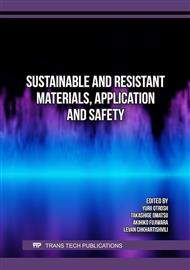[1]
A. Myroshnychenko, V. Loboichenko, M. Divizinyuk, A. Levterov, N. Rashkevich, O. Shevchenko, R. Shevchenko. Application of Up-to-Date Technologies for Monitoring the State of Surface Water in Populated Areas Affected by Hostilities. BULLETIN OF THE GEORGIAN NATIONAL ACADEMY OF SCIENCES. 16 (3) (2022) 50–59.
Google Scholar
[2]
Bashynska, O., Otrosh, Y., Holodnov, O., Tomashevskyi, A., Venzhego, G. Methodology for calculating the technical state of a reinforced-concrete fragment in a building influenced by high temperature. Materials Science Forum. 1006 (2020) 166–172.
DOI: 10.4028/www.scientific.net/msf.1006.166
Google Scholar
[3]
Medved I., Rashkevich N., Otrosh Yu., V. Tomenko. Analysis of Experimental Studies of Titanium Alloy. Materials Science Forum. 1141 (2024) 35–42.
DOI: 10.4028/p-ryw4rj
Google Scholar
[4]
Pasternak, V., Ruban, A., Surianinov, M., Otrosh, Y., Romin, A. Software Modeling Environment for Solving Problems of Structurally Inhomogeneous Materials. In Materials Science Forum. 1068 (2022) 215–222.
DOI: 10.4028/p-h1c2rp
Google Scholar
[5]
Rashkevich N., Shevchenko R., Khmyrov I., Soshinskiy A. Investigation of the Influence of the Physical Properties of Landfill Soils on the Stability of Slopes in the Contex. Materials Science Forum. 1038 (2021) 407–416.
DOI: 10.4028/www.scientific.net/msf.1038.407
Google Scholar
[6]
Bashynskyi, O.I., Peleshko, M.Z., Pazen, O.Yu., Berezhanskyi, T.H., The influence of temperature modes of fire on flexibility of building constructions. Fire safety. 31 (2017) 6–10.
Google Scholar
[7]
Shnal, T., Pozdieiev, S., Nuianzin, O., Sidnei, S., Improvement of the assessment method for fire resistance of steel structures in the temperature regime of fire under realistic conditions. In Materials Science Forum. 1006 (2020) 107–116. Trans Tech Publications Ltd.
DOI: 10.4028/www.scientific.net/msf.1006.107
Google Scholar
[8]
Palazzi, E., Fabiano, B., Analytical modelling of hydrocarbon pool fires: Conservative evaluation of flame temperature and thermal power. Process Safety and Environmental Protection. 90 (2) (2012) 121–128.
DOI: 10.1016/j.psep.2011.06.009
Google Scholar
[9]
Tkachuk, I., Strength of reinforce-concrete columns under force and high temperature influences. On the right of the manuscript. Dissertation for obtaining the scientific degree of Candidate of Technical Sciences in specialty 05.23.01 "Building constructions, buildings and structures". Ukrainian State University of Railway Transport, 2021.
Google Scholar
[10]
Kovalov, A., Purdenko, R., Otrosh, Y., Tоmеnkо V., Rashkevich, N., Shcholokov, E., Pidhornyy, M., Zolotova, N., Suprun, O. Assessment of fire resistance of fireproof reinforced concrete structures. Eastern-European Journal of Enterprise Technologies. 5(1 (119) (2022) 53–61.
DOI: 10.15587/1729-4061.2022.266219
Google Scholar
[11]
Noor-E-Khuda, S., Dhanasekar, M., Thambiratnam, D.P., Out-of-plane deformation and failure of masonry walls with various forms of reinforcement. Composite Structures. 140 (2016) 262–277.
DOI: 10.1016/j.compstruct.2015.12.028
Google Scholar
[12]
Andrii Kovalov, Yurii Otrosh, Oleksandr Chernenko, Maxim Zhuravskij, Marcin Anszczak. Modeling of Non-Stationary Heating of Steel Plates with Fire-Protective Coatings in Ansys under the Conditions of Hydrocarbon Fire Temperature Mode. In Materials Science Forum. 1038 (2021) 514-523.
DOI: 10.4028/www.scientific.net/msf.1038.514
Google Scholar
[13]
Wasim, M., Li, C.Q., Mahmoodian, M., Robert, D. Mechanical and microstructural evaluation of corrosion and hydrogen-induced degradation of steel. Journal of Materials in Civil Engineering. 31(1) (2019) 04018349.
DOI: 10.1061/(asce)mt.1943-5533.0002560
Google Scholar
[14]
Gumenyuk, I.A., Tribotechnical properties of steel 12C-18Cr-10Ni-Тi, surface-modified by combined coatings. Qualifying scientific work on the rights of manuscripts. The dissertation for the degree of a candidate of technical sciences in the specialty 05.02.04 "Friction and wear in machines" (13 - Mechanical engineering). National Aviation University, Kyiv, 2018.
Google Scholar
[15]
Sariturk, B., Seker, D.Z., A residual-inception U-Net (RIU-Net) approach and comparisons with U-shaped CNN and transformer models for building segmentation from high-resolution satellite images. Sensors. 22(19) (2022) 7624.
DOI: 10.3390/s22197624
Google Scholar
[16]
DSTU 9273:2024 Nastanova shchodo obstezhennya budivelʹ i sporud dlya vyznachennya ta otsinky yikh tekhnichnoho stanu. Mekhanichnyy opir ta stiykistʹ. https://online.budstandart.com/ua/catalog/doc-page.html?id_doc=106902 [in Ukrainian].
Google Scholar
[17]
G Guzii, Y Otrosh, O Guzii, A Kovalov, K Sotiriadis. Determination of the Fire-Retardant Efficiency of Magnesite Thermal Insulating Materials to Protect Metal Structures from Fire. In Materials Science Forum. 1038 (2021) 524-530.
DOI: 10.4028/www.scientific.net/msf.1038.524
Google Scholar
[18]
A.S. Bychkov, A.V. Kondratiev. Criterion-based assessment of performance improvement for aircraft structural parts with thermal spray coatings. Journal of Superhard Materials, 41(1) (2019) 53–59.
DOI: 10.3103/s1063457619010088
Google Scholar
[19]
Doskonalennya metodiv obstezhennya ta otsinky tekhnichnoho stanu budivelʹ ta sporud. https://dspace.znu.edu.ua/jspui/bitstream/12345/2047/1/%D0%90%D0%BD%D0%B4%D1%80%D0%B5%D1%8E%D0%BA%20%D0%92.%D0%9A..pdf?utm_source=chatgpt.com [in Ukrainian].
DOI: 10.33941/age-info.com24(5)2018005
Google Scholar
[20]
Loboichenko, V., Nikitina, N., Leonova, N., Konovalova, O., Bondarenko, A., Zemlianskyi, O., & Rashkevich, N. Study of the features of determination of heavy metals in bottom sediments. In IOP Conference Series: Earth and Environmental Science. 1348 (1) (2024) p.012014.
DOI: 10.1088/1755-1315/1348/1/012014
Google Scholar
[21]
Polimeno, M.R., Roselli, I., Luprano, V.A., Mongelli, M., Tati, A., De Canio, G., A non-destructive testing methodology for damage assessment of reinforced concrete buildings after seismic events. Engineering Structures. 163 (2018) 122–136.
DOI: 10.1016/j.engstruct.2018.02.053
Google Scholar
[22]
Golovanevskiy, V., Kondratiev, A., Elastic properties of steel-cord rubber conveyor belt. Experimental techniques. 45(2) (2021) 217 – 226.
DOI: 10.1007/s40799-021-00439-3
Google Scholar
[23]
Kondratiev, А.V., Kovalenko, V.O. Optimization of design parameters of the main composite fairing of the launch vehicle under simultaneous force and thermal loading. Space science and technology. 25, 4(119) (2019) 3 – 21.
DOI: 10.15407/knit2019.04.003
Google Scholar
[24]
Skob, Y., Dreval, Y., Vasilchenko, A., Maiboroda, R. Selection of Material and Thickness of the Protective Wall in the Conditions of a Hydrogen Explosion of Various Power. In Key Engineering Materials. 952 (2023) 121–129.
DOI: 10.4028/p-st1vet
Google Scholar
[25]
Maiboroda, R., Zhuravskij, M., Otrosh, Y., Karpuntsov, V. Determination of the Required Area of Easily Removable Structures to Protect against Progressive Collapse. In Key Engineering Materials. 1004 (2024) p.73–83
DOI: 10.4028/p-v0xa6h
Google Scholar


